FEATURES|COLUMNS|Buddhist Art
Jizo: Japan’s Beloved Savior of Lost Souls
Buddhistdoor Global | 2015-05-15 |
The Buddhist deity Kshitigarbha, or “He who encompasses the Earth,” has a powerful and ubiquitous presence in Japan, where figures of him depicted as a bald-headed priest and often wearing red bibs or other articles of clothing are common not only in Buddhist temples, but also along the sides of roads all over the country. Known in India as early as the 4th century, this bodhisattva is believed to have vowed to save all beings from the torments of Hell during the interim between the passing of the historical Buddha, Shakyamuni (the Buddha of our age), and the arrival of the future Buddha, Maitreya. In the Himalayan Tantric schools, he is worshipped as one of the Eight Bodhisattvas and is represented there as a crowned, bejeweled bodhisattva figure seated on a lotus and holding a sacred jewel in his right hand. However, he was never a popular figure of worship in either India or the Himalayas.
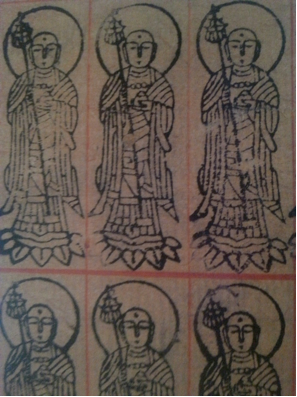
Printed multiple images of Jizo. Japan,
Muromachi period (1333–1574), ink on paper.
Image courtesy of Sam Fogg, London.
In East Asia, and in Japan in particular, on the other hand, he has been revered from an early date. As the “good” Judge of Hell, he is believed to rule over Yama and the nine other Kings or Judges of Hell, and in this capacity, is credited with being able to save souls from the punishments issued by these ten infernal judges. Because of this power, together with additional abilities that have been ascribed to him over the centuries, he has become one of Japan’s most widely loved and worshipped deities, and his presence is felt there well beyond the grounds of Buddhist temples.
Kshitigarbha was introduced to Japan in the 8th century, when a statue of him was brought from China and placed in an important Buddhist shrine in the ancient capital of Nara. Known in Japan as Jizo, this deity’s early popularity reached a peak during the late Heian era (794–1192), when the rise of the Pure Land (J. Jodo) Sect intensified fears among the people about Hell in the afterlife. Along with the Buddha associated with the Pure Land Sect, Amitabha (J. Amida), who promised rebirth in his glorious Western Paradise, Jizo, since he was believed to be able to save devotees from the torments of Hell, gained a significant following among Japanese Buddhists. It was probably around this time that he was first depicted as a priest, with a shaved head and priest’s robes, and carrying a staff in his right hand and a sacred jewel in his left. Such a representation is unique among bodhisattvas, and may originate from the belief that the bodhisattva first appeared to the Buddha in the form of a priest.
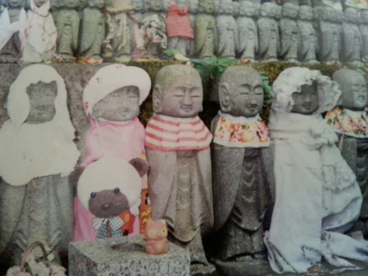
Rows of Jizo figures, Hasedera Temple, Kamakura,
Japan. Photograph by the author.
Sometime around the 14th or 15th century in Japan, Jizo became associated in particular with the souls of dead children, who, according to popular Buddhist belief, became stranded in a limbo known as Sai no Kawara, the “River Beach of Sai.” There, they were forced to construct towers of pebbles as a way of attaining rebirth, only to see them knocked down daily by the Old Hag of Hell, Datsueba, who guards the Sanzu Gawa, the Buddhist equivalent of the Greek mythical River Styx. Since this time, images of Jizo have been commissioned by bereaved parents and placed in temple graveyards in the hope that Jizo will travel to Sai no Kawara and relieve the souls of their children from these tortuous labors. These small stone figures of Jizo often wear clothing or hold toys belonging to the children. Major temples, such as the Hasedera in Kamakura, have sections of their graveyards filled with row upon row of such figures, smiling sweetly and dressed in children’s clothing, donated by parents as a prayer for the repose of their lost children.
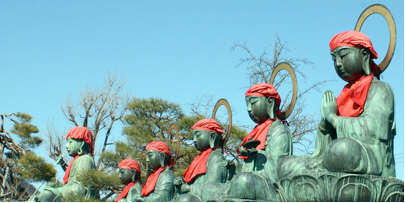
Six Jizo figures, Zenko-ji, Nagano, Japan. Bronze. Image
from Shinshusnow.
Other, larger figures of Jizo can be found dressed in red bibs and caps, but are not necessarily connected with the death of children. In Japan, the color red has for many centuries been worn protectively to quell demons and cure illnesses, and has also become associated with deities of healing, fertility, and childbirth. As well as being associated with saving the souls of children, Jizo has been believed to aid women wishing to conceive, and worshipped as a holy physician with the power to cure various illnesses. So, images of him are often decked in red to signify his protective healing powers and to invoke his powers to heal the loved ones of worshippers. At many temples, including the famous Zenko-ji in Nagano, a group of Six Jizos (Roku Jizo) carved from stone or cast in bronze and adorned with red bibs and caps offers protection to worshippers. The number in this group refers to his role as Master of the Six Buddhist Realms of Rebirth (namely the realms of humans, gods, animals, the warlike beings known as ashuras, hungry ghosts, and Hell) and his ability to penetrate all of these locations to relieve suffering.
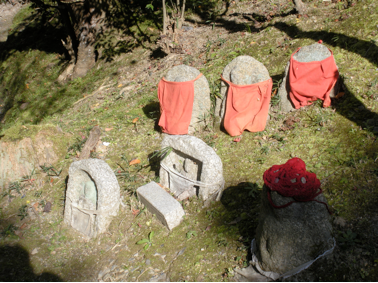
Weather-worn figures of Jizo wearing red bibs and caps,
Kiyomizu Temple, Kyoto, Japan. Stone. Photograph by
the author.
Perhaps because of his ability to cross from one Buddhist realm to another, Jizo has also long been associated with travel and regarded as a protector of travelers. This function of Jizo merged at some point in Japan with the native Shinto belief in gods of borders and transitions called dosojin (“road ancestor spirits”). Originally phallic stones symbolizing fertility, these dosojin were erected at the edge of a village or at a crossroads in Japan to protect against evil influences. Over time, many of these figures were replaced by figures of Jizo, sometimes solitary but often, again, in groups of six. Now, throughout the countryside and even in large cities, small Jizo figures can be seen lining Japan’s roads and pilgrimage routes as protectors of travelers and of anyone living close by.

Painting of six Jizos by Soen. Japan, Hita,
c.1990. Image courtesy of the author.
Even today, many Japanese believe in Jizo’s powers, extending even beyond the protection of travelers, children, the sick, and lost souls in Hell. He is prayed to at hundreds of temples throughout the country to bring rain, to guarantee long life and good fortune, to help farmers and fishermen, and even to provide protection in battle. Although typically depicted as a young, bald-headed, sweet-faced priest, he is occasionally depicted surrounded by children, wearing armor, or even in female form, depending on the particular power he is believed to possess at a particular temple. Because of his lovable appearance and function as protector of children, it is not surprising that he is also often depicted as a cute, cartoon-like figure. There is no disrespect in these representations; rather, they demonstrate how beloved the deity Jizo is to the people of Japan.
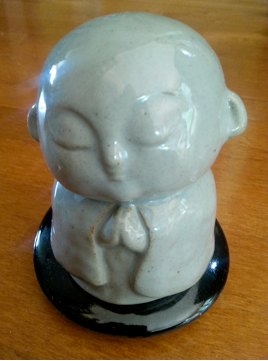
Incense burner in the form of Jizo.
Japan, 21st century, ceramic on wood
base. Image courtesy of the author.

Comments:
Share your thoughts:













